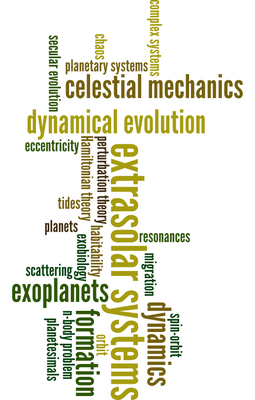Formation
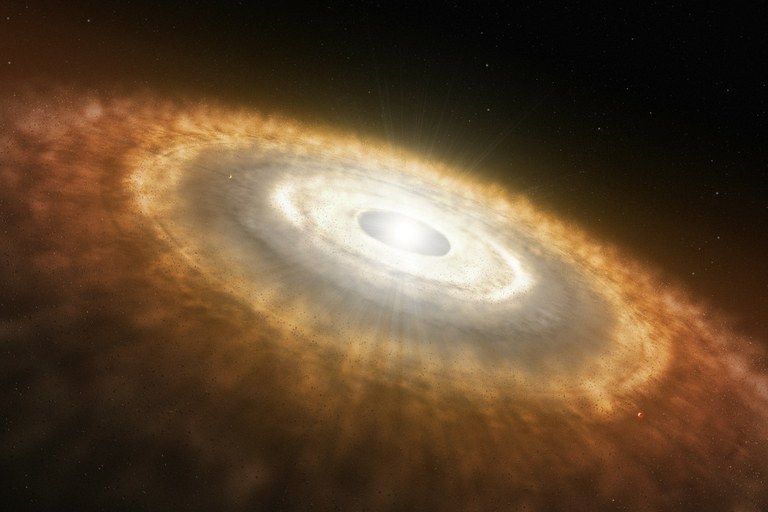
Giant-PLaneT Systems formation
Planet-planet interactions during migration in the protoplanetary disc are invoked to explain the formation of the eccentric and inclined orbits of exoplanets detected by radial velocity. On the one hand, the interaction between the giant planets and the protoplanetary disc tends to shrink their semi-major axis (Type II migration) and keeps them on coplanar and near-circular orbits. On the other hand, gravitational interactions in multi-planetary configurations can lead to an excitation of the planetary eccentricities and inclinations. In particular, capture in mean-motion resonance can be followed by an inclination-type resonance, while dynamical instabilities among the planets can result in planet-planet scattering and a subsequent excitation of eccentricities and inclinations, even during the gas phase. We investigate a formation scenario of giant-planet systems based on the combined action of the gas disc and planet-planet interactions during the disc phase. Using n-body simulations, we have shown that eccentricity and inclination excitation can be acquired under the realistic hypothesis that all the giants are initially in the midplane of the gas disc (e.g. Libert & Tsiganis, 2011a). As a consequence, these works highlight that systems with mutually inclined giant planets could exist.
The influence of the gas disc on the planetary inclinations was not considered in the previous studies. To this end, we have performed, in collaboration with the Observatory of Nice, 3D hydrodynamical numerical simulations of protoplanetary discs with embedded high mass planets and derived an explicit formula for eccentricity and inclination damping, suitable for n-body simulations, as a function of eccentricity, inclination, planetary mass and disc mass (Bitsch et al. 2013).
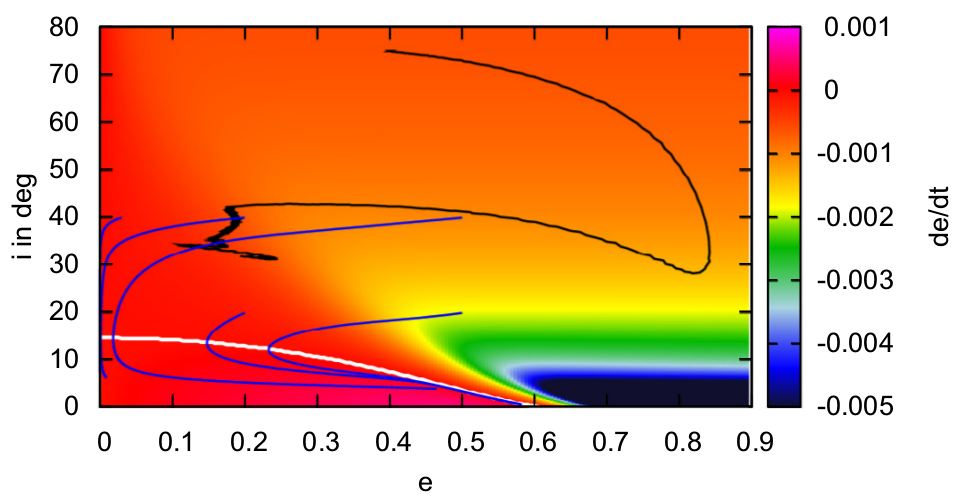
Figure from Bitsch et al. 2013: The dynamics of inclined planets (< ~ 40°, blue curves) tends to a final state: planets end up in the midplane of the disc and can then, over time, increase their eccentricity as a result of interactions with the disc. Highly inclined planets (> ~40°) can undergo a Kozai-cycle with the disc that makes it hard to predict the exact evolution of the planet and its orbital parameters at the dispersal of the gas disc.
This eccentricity and inclination damping formula has been included in our n-body parametric study (Sotiriadis et al. 2017). To investigate the influence of the eccentricity and inclination damping due to planet-disc interactions on the final configurations of planetary systems, we have followed the orbital evolution of thousands numerical experiments of three giant planets in the late stage of the gas disc, exploring different initial configurations, planetary mass ratios and disc masses. Although the majority of the multiple systems of our simulations are quasi-coplanar, ~ 5% of them end up with planets with high mutual inclination (> 10 degrees). We show that the parameters of the final system configurations are in very good agreement with the semi-major axis and eccentricity distributions of the observations, showing that planet-planet interactions during the disc phase could have played an important role in sculpting planetary systems.
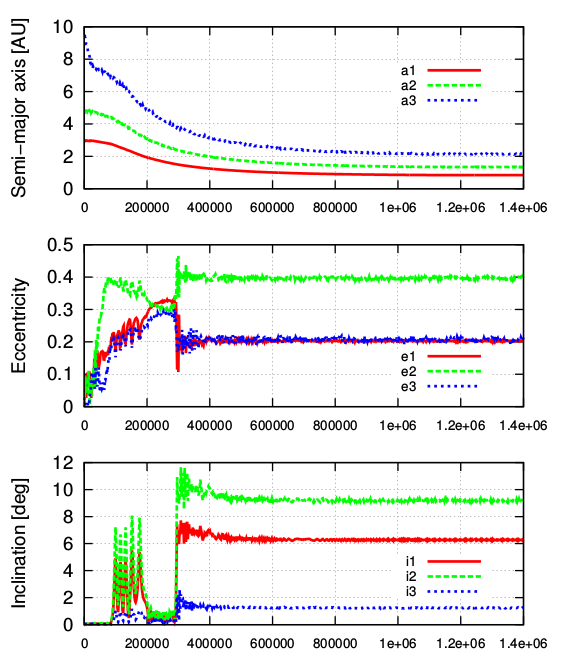
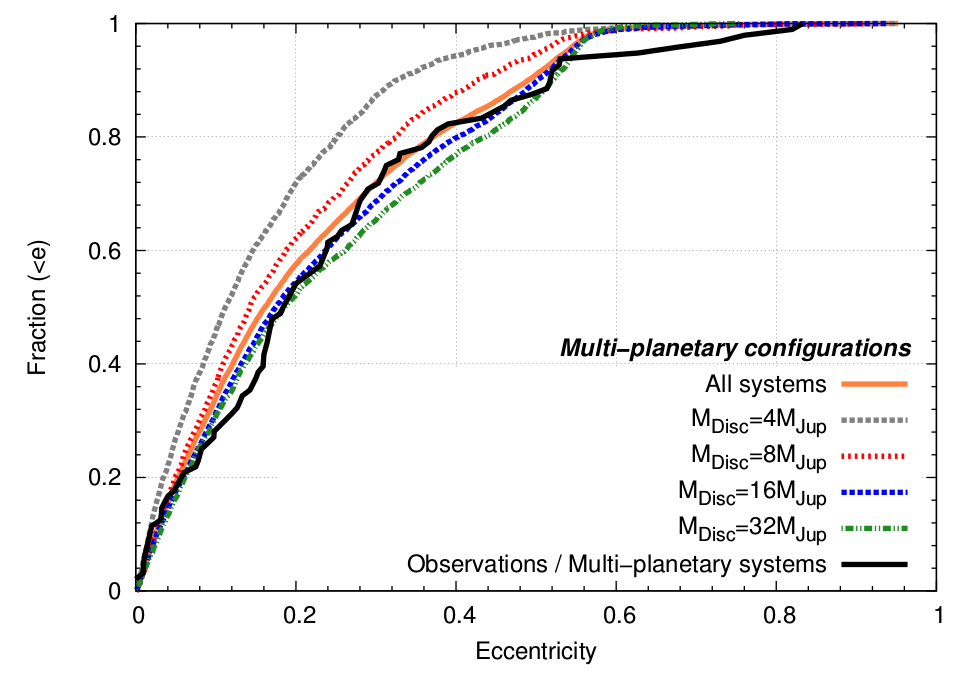
Figures from Sotiriadis et al. 2017: Eccentricities are already well-diversified at the dispersal of the disc, despite the strong eccentricity damping exerted by the gas disc, and subsequent inclination increase is possible.
Importance of two- and three-body resonance captures occuring during the migration of the planets have been highlighted, as well as the most frequent mechanisms producing inclination increase. While inclination-type resonance asks for large eccentricities to be acquired during the migration of the planets, we have shown that inclination excitation can also be produced at small to moderate eccentricities in two-planet systems that have previously experienced an ejection or a merging, by (temporary) capture in inclination-type resonance (Libert et al. 2018). The possible proximity of the non-coplanar systems to spatial periodic orbits contributes to maintaining their mutual inclination over long periods of time.
More information:
Libert, A.-S., Tsiganis, K., Formation of ‘3-D’ multi-planet systems by dynamical disruption of multiple-resonance configurations, Monthly Notices of the Royal Astronomy Society, 2011, volume 412, issue 4, pp. 2353-2360
Bitsch, B., Crida, A., Libert, A.-S., Lega, E., Highly inclined and eccentric massive planets. I. Planet-disc interactions, Astronomy & Astrophysics, 2013, volume 555, id.A124, 13 pages
Sotiriadis, S., Libert, A.-S., Bitsch, B., Crida, A., Highly inclined and eccentric massive planets: II. Planet-planet interactions during the disc phase, Astronomy & Astrophysics, 2017, volume 598, A70
Libert, A.-S., Sotiriadis, S., Antoniadou, K. I., Influence of periodic orbits on the formation of giant planetary systems, Celestial Mechanics and Dynamical Astronomy, 2018, accepted
Terrestrial PLanet Formation
A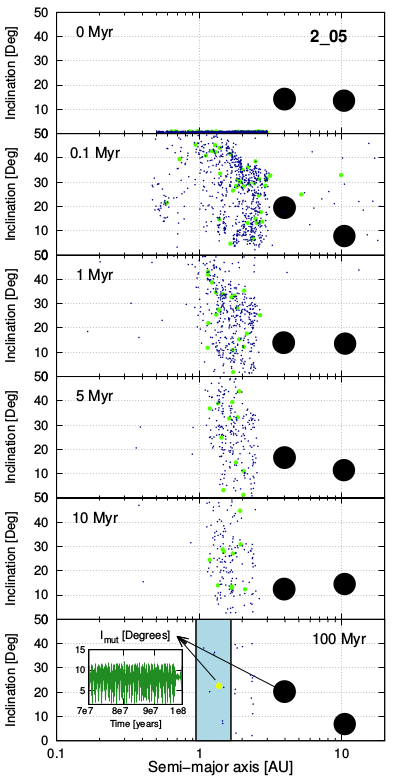 fter the protoplanetary disc phase (a few Myr), giants planets, which have accreted their gaseous envelopes, affect gravitationally the remaining thousands of solid planetesimals and the tens to hundreds planetary embryos in their neighborhood. The so-called "post-oligarchic growth" phase is the last phase of the terrestrial planet formation process and occurs on a timescale of 10^7 - 10^8 years. The already formed giant planets have an essential and important impact on the above-mentioned process and eventually on the final architecture of the planetary system.
fter the protoplanetary disc phase (a few Myr), giants planets, which have accreted their gaseous envelopes, affect gravitationally the remaining thousands of solid planetesimals and the tens to hundreds planetary embryos in their neighborhood. The so-called "post-oligarchic growth" phase is the last phase of the terrestrial planet formation process and occurs on a timescale of 10^7 - 10^8 years. The already formed giant planets have an essential and important impact on the above-mentioned process and eventually on the final architecture of the planetary system.
In Sotiriadis et al. 2018, we have studied the impact of inclined and eccentric massive giant planets on the terrestrial planet formation process. The physical and orbital parameters of the giant planets considered arise from n-body simulations of three giants in the gas disc, as described hereabove. At the dispersal of the gas disc, the two- and three-planet systems interact with an inner disc of planetesimals and planetary embryos. We have investigated the mass and orbital parameters of the terrestrial planets formed by our simulations.
While co-planar giant systems harbour more terrestrial bodies, generally as massive as the Earth and mainly on low eccentric and low inclined orbit, terrestrial planets formed in systems with mutually inclined giant planet systems are generally fewer, less massive (~0.5 Earth masse) and with higher eccentricities and inclinations. This work shows that terrestrial planets can form on stable inclined orbit through the classical accretion theory.
More information:
Sotiriadis, S., Libert, A.-S., Raymond, S., Formation of terrestrial planets in eccentric and inclined giant planet systems, A&A, 2018, accepted
Fundings:
- F.R.S.-FNRS ExtraOrDynHa (Extrasolar Orbital Dynamics and Habilitability) Research Project (2013-2017, Grant No. T.0029.13)
- Hubert Curien / Tournesol fellowship for a bilateral collaboration with the Astrophysics laboratory of Bordeaux (WBI, Wallonie-Bruxelles International, 2016)
-
Computational resources were provided by the Consortium des Équipements de Calcul Intensif (CÉCI), funded by the Fonds de la Recherche Scientifique de Belgique (F.R.S.-FNRS) under Grant No. 2.5020.11.

